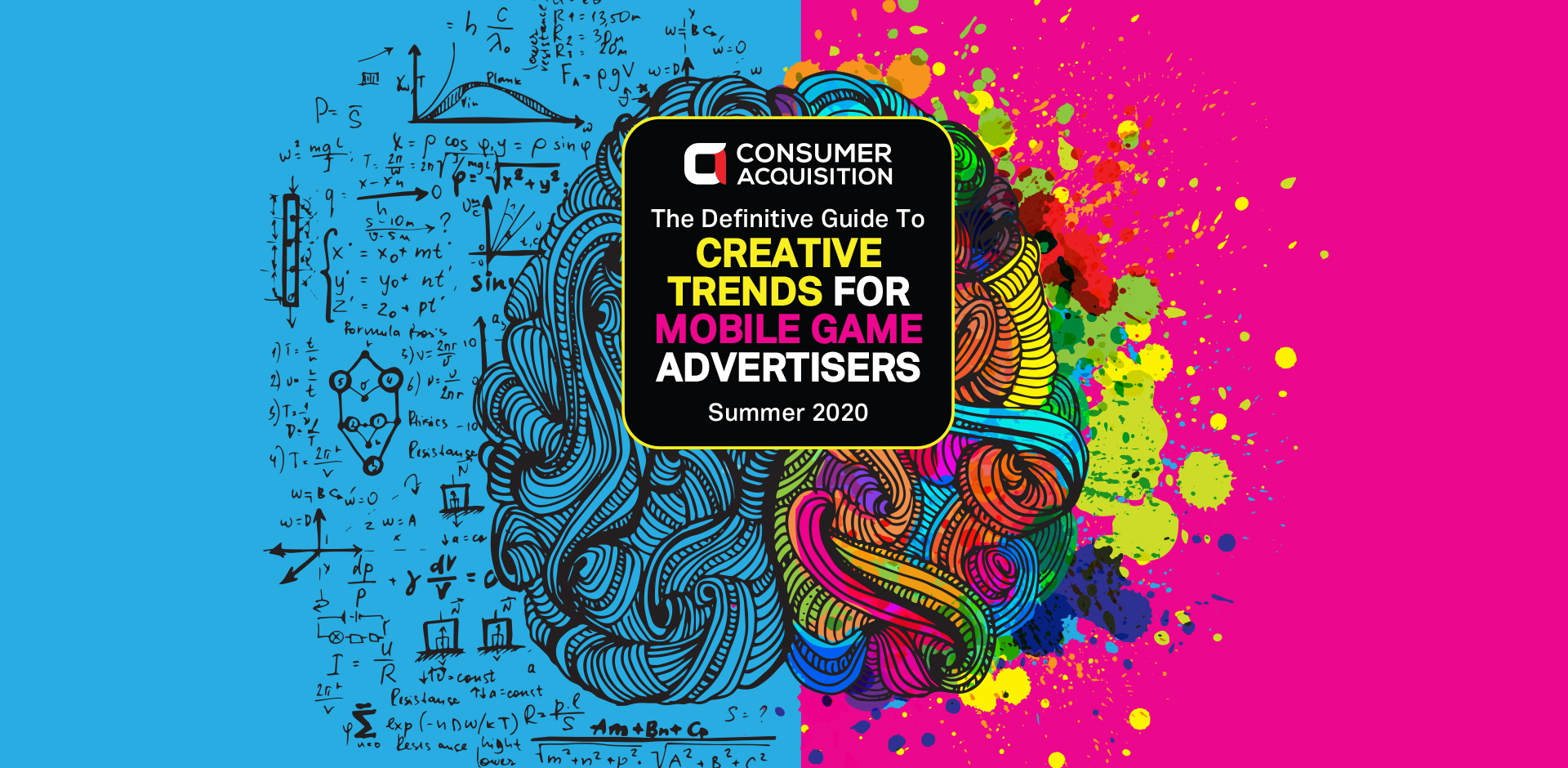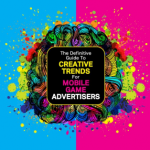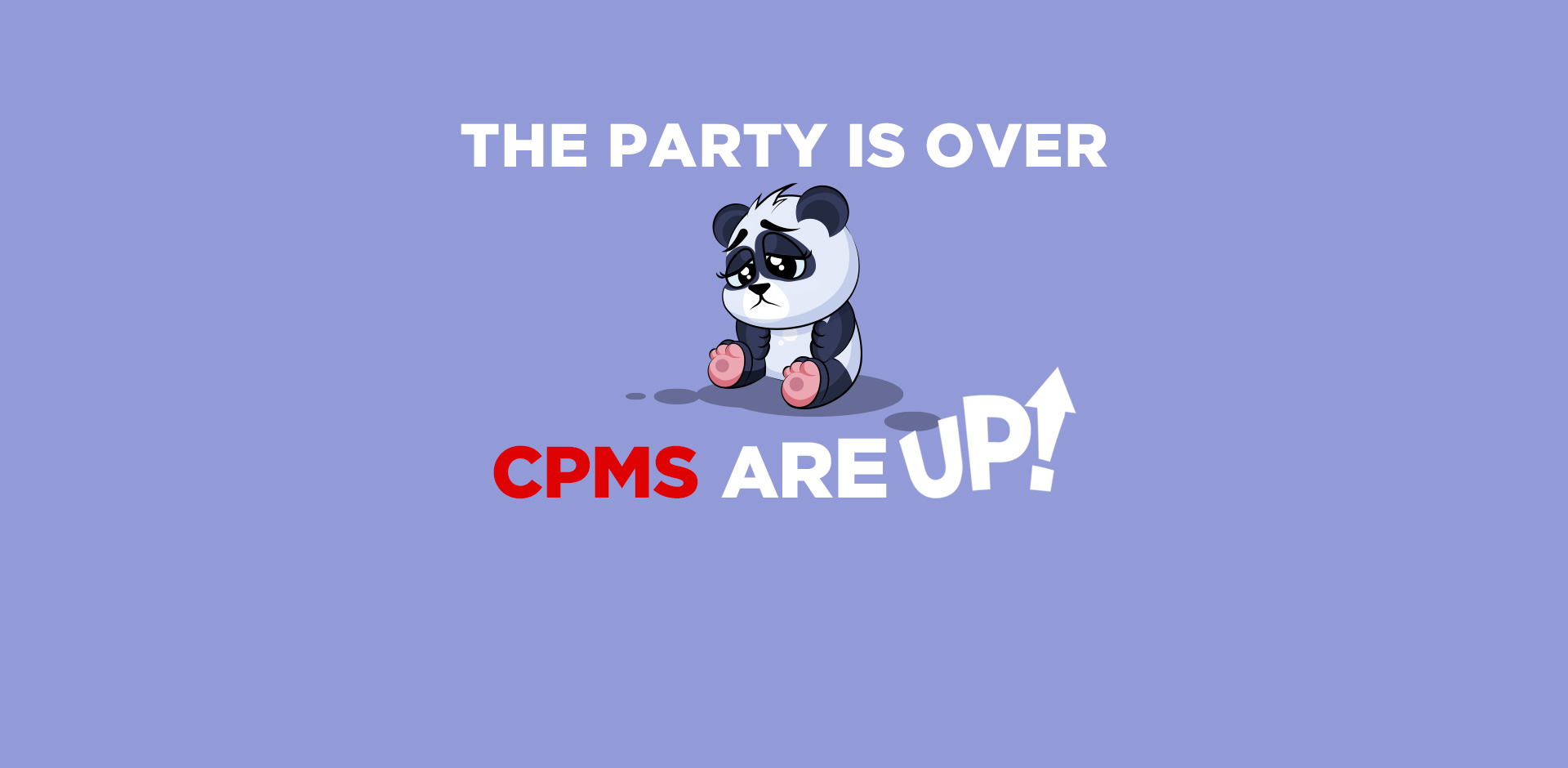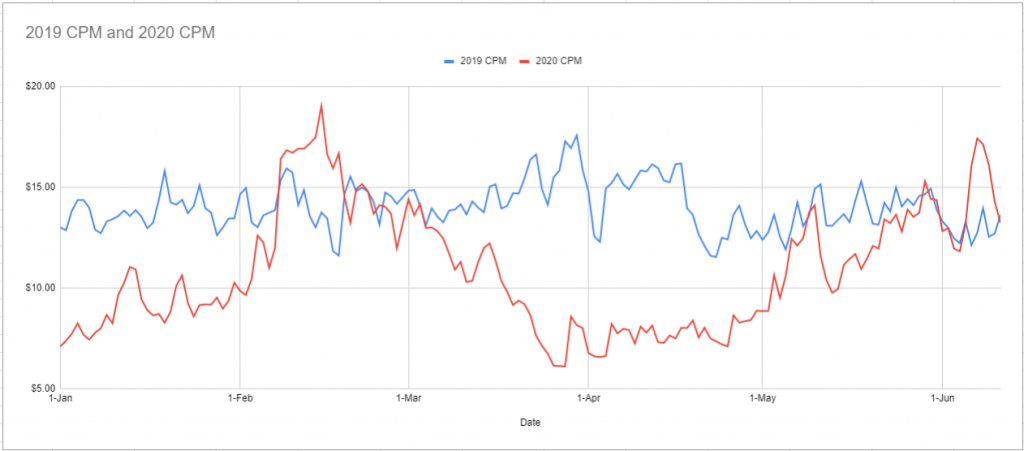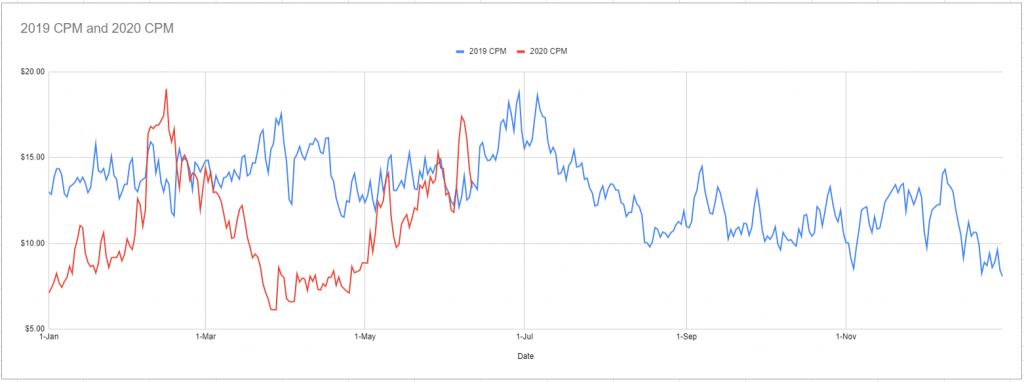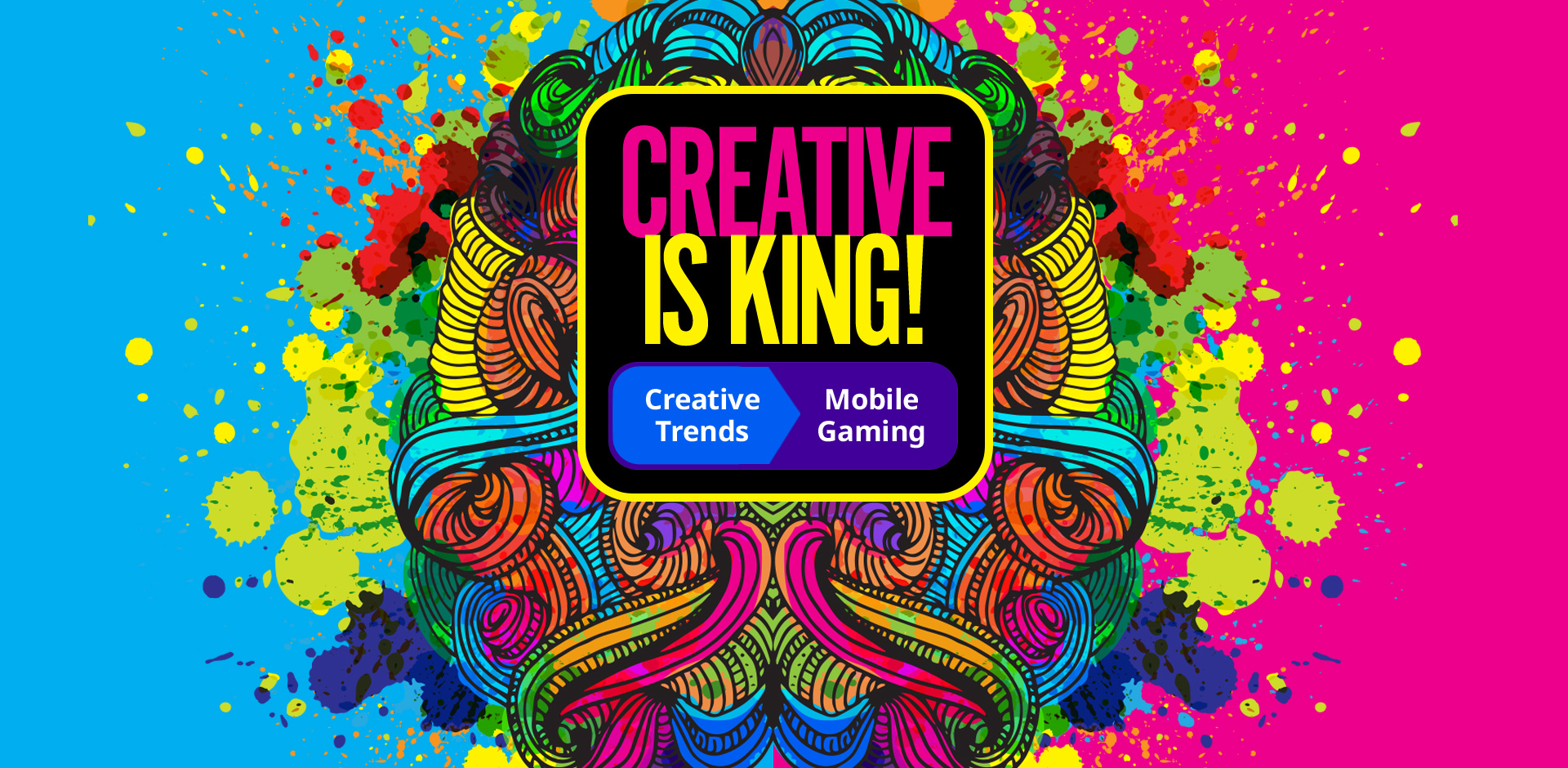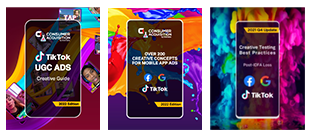UA advertising for mobile gaming has gone through some big changes in the last few years. AI is automating more and more of media buying, as the best practices outlined in Facebook’s Structure for Scale framework demonstrate.
The key elements of the Structure for Scale recommendations are:
- Auto Advanced Matching: Accurately attribute conversions and increase your audience size.
- Account Simplification: Simplify your ad account set up to improve efficiency.
- Automatic Placements: Show ads across the Facebook Network where they’re likely to perform best.
- Campaign Budget Optimization: Find the best way to spend across your ad sets.
- Dynamic Content & Language Optimization: Auto optimize creative for right placement / person / time.
If that looks different than how you’re managing UA campaigns right now, it’s time to bring your advertising – and your entire UA program – into 2020.
Why Creative Is So Important
Creative is an advertiser’s best opportunity for a competitive advantage in social advertising, and it has been since 2019. As the AI optimizing the ad platforms has gotten better and better, it’s leveled the playing field for advertisers big and small.
Here’s why:
1. Expensive, third-party automated adtech platforms aren’t as much of a competitive advantage as they used to be. Facebook and Google’s platforms have integrated the best features of those tools and offered them as standard features to campaign dashboards. All that fancy adtech is now available in your ad accounts, for free. However, if you are spending over $250,000 per month or running multiple titles, an inexpensive ad management platform like AdRules can greatly simplify your workflow and increase productivity.
2. If you’re spending less than $250,000 per month, you may not need expensive, high-end ad jockeys. Automation features have taken a lot of the controls away from UA managers and ad accounts with smaller ad spends have become easier to manage. However, if you are spending over $250,000 per month or across several networks, you may find it helpful to look for inefficiencies in automated solutions. There are still many levers where a rockstar UA manager will outperform an algorithm.
Not All Creative is Created Equal
Those two factors alone leave creative as the most critical competitive advantage. Because you can now run powerful campaigns without adtech, and lower-spending advertisers can actually get good results, two key competitive advantages are gone. Creative is now critical.
The data backs this up. After managing over $3 billion in ad spend, we’ve seen creative prove itself over and over as the single-best driver of ROAS.
Across our portfolio of accounts, we’ve found that 75% of the ROAS gains we’ve generated for clients can be directly attributed to creative optimization. Compare that to 15% of the ROAS gained from audience expansion, and 10% of the ROAS gained from media buying tactics and optimization.
Audience expansion and media buying tactics are still fantastic tools for the Rockstar UA manager, but creative wins hands down. Creative is king.
But not all creative is created equal.
Just pumping out more and more creative variations from winning ads won’t give you the advantage you need. You need high-performance new concepts and control-beating fresh ideas. Those can be hard to find. Only 1-3 ad concepts out of 20 ever beat the control.
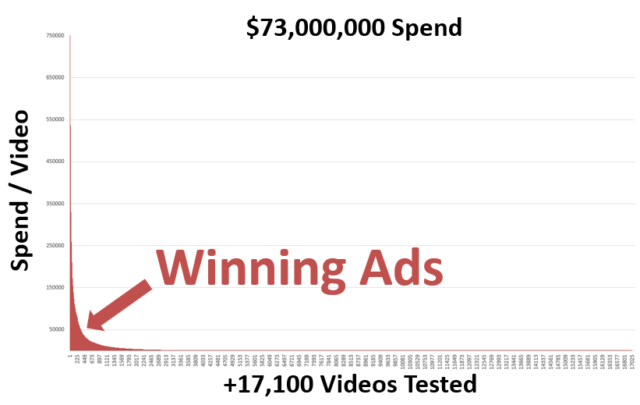
To know which creative assets and elements deliver big results, you need an efficient, accurate testing system. Without efficiency, it’s easy to blow your budget on testing variations that end up generating a disproportionate percent of non-converting spend.
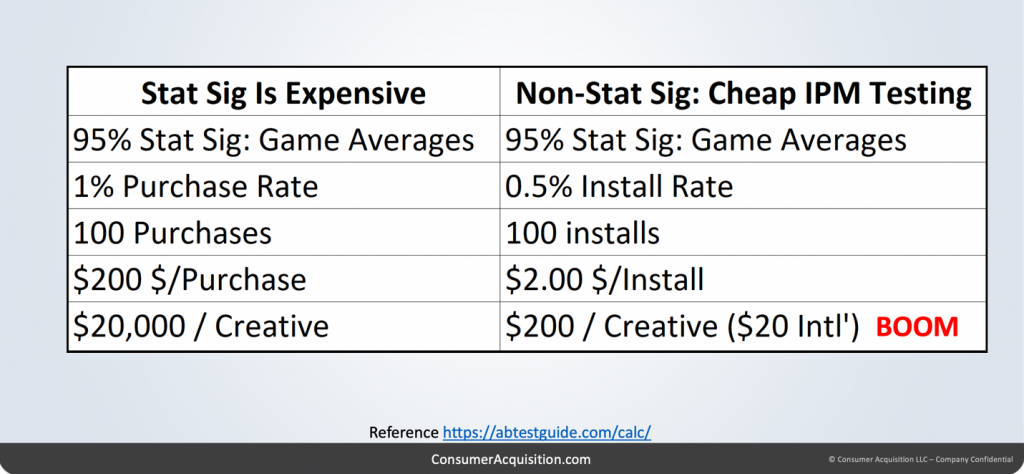
This can be more a challenge than it might seem. Beating the control is surprisingly hard… but more about that in a moment.
Creative Tunnel Vision and How to Overcome It
Even with a world-class testing methodology and creative optimization process, your creative team needs fresh ideas. They have to be aware of all the trends in ad creative that your competitors know about and are already taking advantage of.
To increase the success rate of creative testing while eliminating creative tunnel vision, we are sharing our proprietary creative strategies for gaming genres. We’ve reviewed thousands of Facebook and Google ads to create a “visual taxonomy” of creative trends. We use those trends to generate a list of fresh creative concepts informed by competitive ads, player motivations, and advertiser performance.
As Picasso said, “Good artists borrow, great artists steal!” Once you identify your competitors’ best ads, you have an endless supply of “tested” concepts. However, we have found that analyzing competitive creative, as challenging as it is, is not a UA or Design function. It appears to be a cross-disciplinary exercise.
At this particular snapshot in time, in early June 2020, we’re seeing trends like these drive ad performance:
- Connect the Dots
- Puzzles
- Noob vs Pro
- Hidden Object
- Influencers
Again: These trends come and go faster than fashion, and you need to be in touch with the heartbeat of online advertising across thousands of advertisers to even recognize the trends in the massive number of ads launched every day. Then, once you’ve recognized them, you need to adapt these creative trends so you can use them in your own ads. Get it all right, then test it with a super-efficient creative testing system, and you win the prize: New ad creative that beats the control.
It’s all a little bit like baseball… you’re only as good as your last hit.
Staying Ahead of Trends
Trying to keep up with trends that evolve so rapidly is hard. Trying to do it while you maintain ROAS is even harder. And expecting the same team of people to do it over and over again, week after week… is damn near impossible. Eventually, almost covertly, creative teams learn what works and what fails and then “play it safe” with their creative. They’ll default back to their greatest (and safest) hits of the past, and become just a little bit too cautious about testing any out of the box ideas that might not work. We call this “creative tunnel vision”.
Unfortunately, while many out of the box ideas don’t work, some will. And one or two of those ads – those unlikely, out of the blue winners – could have delivered you a 10-40% leap in ROAS.
But if your team never develops those out of the box ideas, they’ll never test them. You’ll never know how much revenue you’ve missed.
This is why an outside team can be so helpful. And why competitive analysis should be a core skill of somebody in every creative team.
Competitive analysis has two key benefits:
- It lets you peer into an almost endless library of tested concepts (tested with your competitors’ ad budgets, not yours).
- It increases your success rate for your new concepts, so your entire testing program involves a lot less risk.
Think of all this shared knowledge as the “wisdom of creative crowds.” Fortunately, we have ample resources to make competitive analysis efficient. Creative Trend tools like AdRules are great, as are SocialPeta and AppAnnie and many others. There’s even Facebook’s ad library, which is completely free, though it only lets you see which ads your competitors are running, not how those ads have actually performed.
If that’s not enough, you can also check out our resource of competitive video ads from Facebook and Google AC advertisers. Just remember to check competitive benchmarks data so you can recognize what’s breakout performance and what’s just average for that genre.
Creative Trends for Mobile Gaming & Recommendations
So creative trends for mobile gaming change fast – but they also vary dramatically across genres. And so while it is good to know broad creative trends, you’ll also want to hone in on your particular niche. Of course, you’ll also want to overlay all this with actual performance data. We want to chase trends that boost ROAS, not just chase every trend that comes along.
To get you started with this, we’ve developed seven genre-specific creative trend reports. Here are the highlights of two of them:
- Paper Puzzle: Mimicking gameplay with a paper version.
- Scientific claims: “30 minutes a day sharpen your brain” “Neuroscientists recommend playing this game to stay young.”
- Challenges: “What’s Americans’ favorite food?” “Can you find this item?”
- Reasons to play the game: Meet friends, upgrades, learn new words, game tutorials.
- Whimsical: “The first word you see is your destiny!”
- Relaxing themes: “What are you doing to decompress?” Soothing landscapes and music.

- App Explainers: Videos explaining how the game or app works with users/players, screenshots/gameplay, and rewards. (Caesars Casino, Gin Rummy Plus, Inbox Dollars)
- Real Winners/Testimonials: Videos featuring real winners and amounts they’ve won. (Lucktastic, Lucky Day)
- Newsreel: Videos showing newsworthiness of the app based on real or fake news coverage. (House of Fun Slots, Jackpocket)
- Casino Lifestyle: Videos with colorful slot machine graphics and/or big band music. (Caesars Casino, Gin Rummy Plus, WSOP, Slotomania, Spades Plus, Spin to Win Slots)
- Community: Videos featuring gameplay between players, or texts between players regarding the app itself. (IBotta, WorldWinner)
- Winners/Testimonials: Videos featuring winning moments and real winner testimonial. (Skillz)
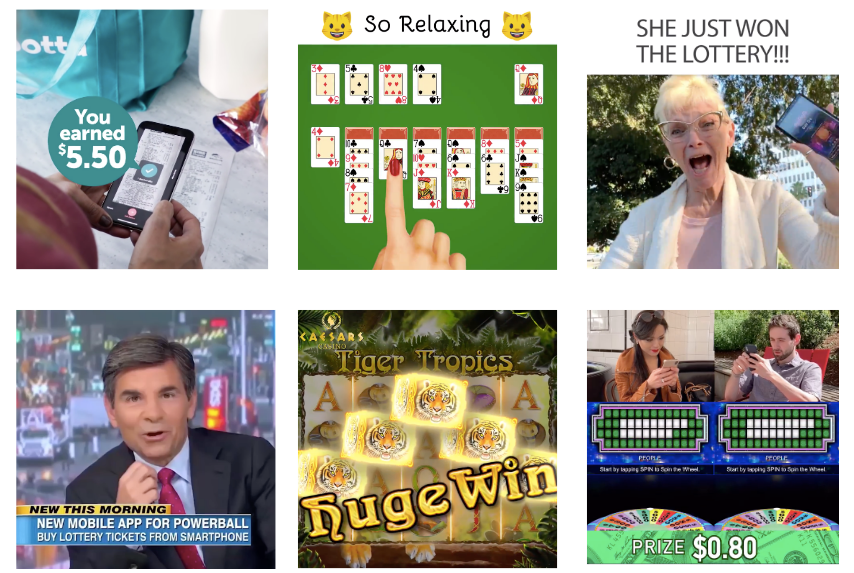
If you’re not seeing your genre, or you want to see the full reports (they go into much more detail) check out our other creative strategy decks:
So monitoring creative trends and doing an in-depth competitive analysis is great. But cutting edge advertisers don’t stop there. They also incorporate player profiles and user motivations into their creative strategy.
Player profiles are actually an old idea in game design, but they’re a very new idea for game advertising. As of late last year, only about 10% of the UA teams we reached out to were using player profiles, and they tended to be the most elite advertisers.
So what are player profiles? The way most UA teams are using them is a hybrid of principles from game theory and a concept known as “horizontal segmentation” borrowed from the consumer goods industry.
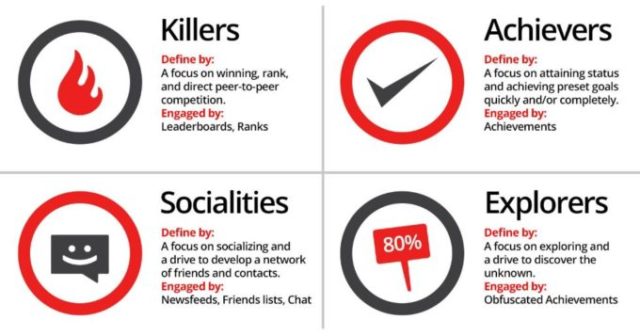
Here’s the thumbnail version of why this new theory of creative is so powerful: If you can identify certain customer preference clusters within your client base, and if you can then develop products that are designed specifically to fulfill those preferences, you can align your messaging with their motivations for playing your game or trying your service.
Here’s what a fully developed player profile might look like if it was used within a creative brief. This is all fake data, but it gives you an idea of how powerful this approach to creative development can be.
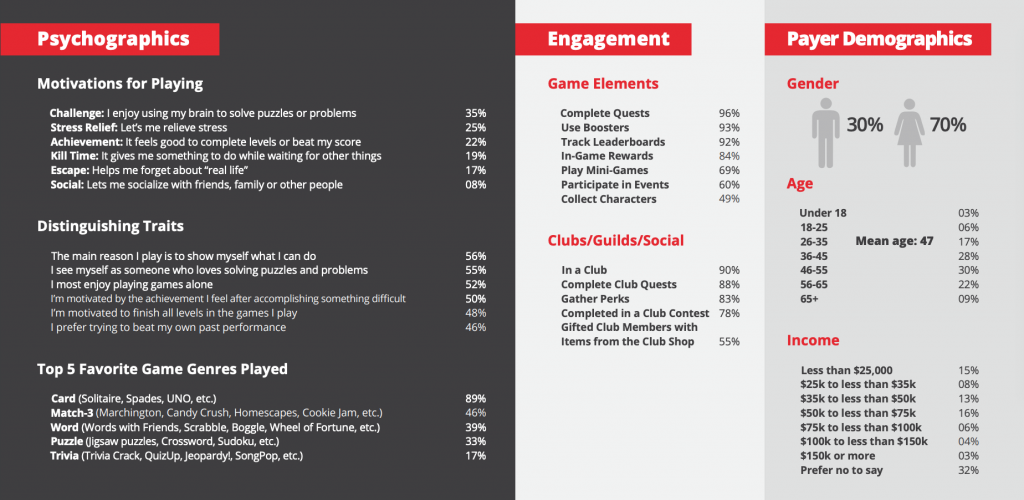
That’s the idea behind player profiles. It’s also a demonstration of another megatrend in UA advertising that we’ve been seeing for a while: The merging of data science and UA teams.
This merger may become more pronounced as UA advertising automation continues to “streamline” teams, and as ad creative and data science teams start to share ideas and assets with each other even more than they do now.
Mobile Gaming Emotional Hooks
Once you’ve got your mobile gaming app’s player profiles dialed in, then you can incorporate these six mobile gaming emotional hooks into your creative so the strategy is complete.
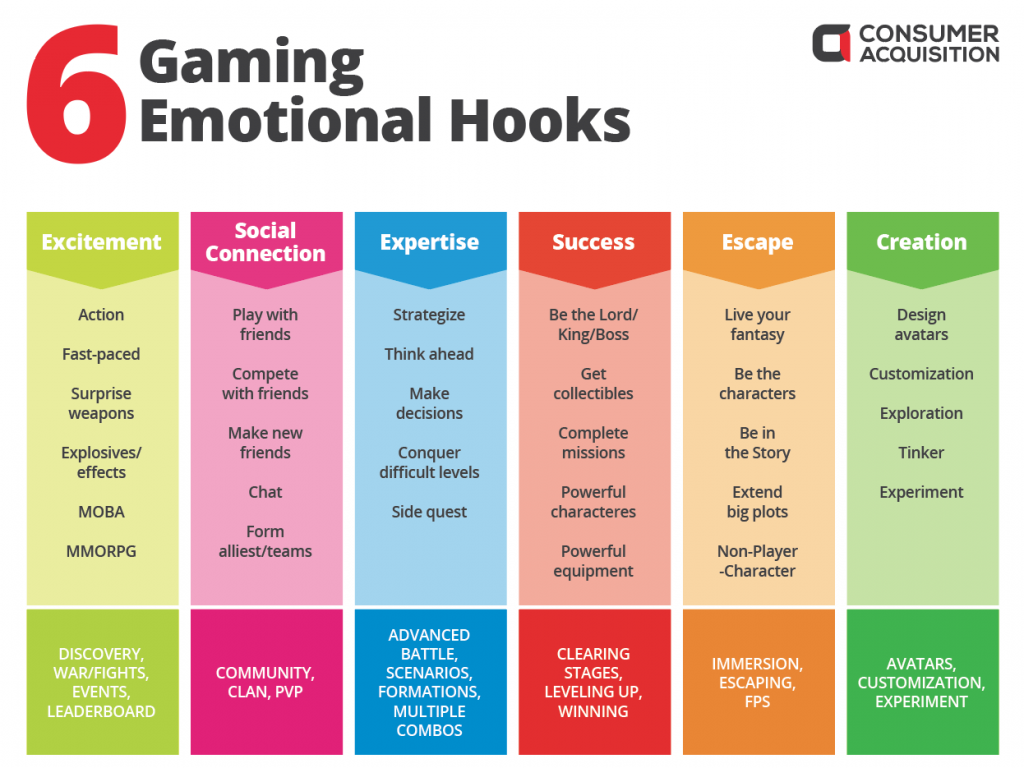
Understanding mobile gaming player profiles and emotional hooks may change how you see ads forever. It’s a wickedly-effective framework for motivating users, but also a great lens to use as you analyze competitors’ creative.
Creative Testing: Why The Control Is So Hard To Beat
So you know creative is the best path to high ROAS. And you know competitive analysis, creative trends, and player personas and motivations should all be shaping your creative strategy. You know all this requires a lot of testing – and efficient testing, at that – to surface the high-performance creative you need to keep your campaigns alive.
Nice start… but you’re not done.
You see, Facebook’s testing algorithm is more sophisticated than it might first appear to be.
We’ve gotten to know it well after performing more than 10,000 A/B and multivariate tests on Facebook and its competitor, Google. We produce more than 100,000 video and image ads every year. We have managed over $3 billion in paid social ad spend.
We’d like to share what we’ve learned from that work.
Testing Mobile Gaming Ad Creative
We test a lot of mobile gaming ad creative, but we test in a unique way. When we test, our goal is to compare how new concepts will perform versus the winning video (control) to see if the challenger can outperform the champion. Why? Because if you can’t outperform the best ad in a portfolio, you will lose money running the second or third place ads. A new ad either needs to beat the best-performing ad (the control), or you haven’t really gained anything.
Keep in mind, also, that we focus on these verticals: gaming, e-commerce, entertainment, automotive, D2C, financial services, and lead generation. So what we have learned is specific to those niches. We have not tested our process beyond the aforementioned verticals.
Our testing process has been architected to save both time and money by:
- killing losing creatives quickly
- significantly reducing non-converting spend
Our AdRules Software via the Facebook API
While our process can generate both false negatives and false positives (as almost any test can), it is designed to deliver maximum efficiency in exchange for those risks. We typically allow our tests to run between 2-7 days to provide enough time to gather data without requiring the capital and time required to reach statistical significance (StatSig). We also always run our tests using our AdRules software via the Facebook API.
Our insights are specific to the above scenarios and not a representation of how all testing on Facebook’s platform operates. In some cases, it is valuable to retain learning without obstructing ad delivery.
To be clear, our process is not the Facebook best practice of running a split test and allowing the algorithm to reach statistical significance (StatSig), which then moves the ad set out of the learning phase and into the optimized phase.
The insights we’ve drawn are specific to these scenarios we outline here and are not a representation of how all testing on Facebook’s platform operates. In some cases, it is valuable to have old creative retain its learning history to seamlessly A/B test without obstructing ad delivery.
If you’d like to learn more about our creative testing system, and what we’ve learned about Facebook’s testing algorithm, check out our fun explainer video or read our white paper on the subject.
Here’s a summary of what our tests have shown:
1. During our testing, we noticed that Facebook maintains creative history for the current video winner during an A/B test. This makes the control video very difficult to beat when using our IPM testing methodology.
2. Ads that are visually similar to the control appear to be grouped together in terms of how the algorithm treats them. They are also automatically given a higher IPM (impressions per thousand) value, even at the very start of a test.
3. Any new creative that is visually very different from the control does not share this creative history. This “very different creative” will start the test with a lower IPM. As a consequence of this, any creative that is visually very different from the control will require more time and money to “warm-up” its creative history. It will also require more time and money to get out of the learning phase and into the optimized phase before it ever has a chance of competing against the control.
Here’s what this all looks like in terms of the performance of different mobile gaming ads:
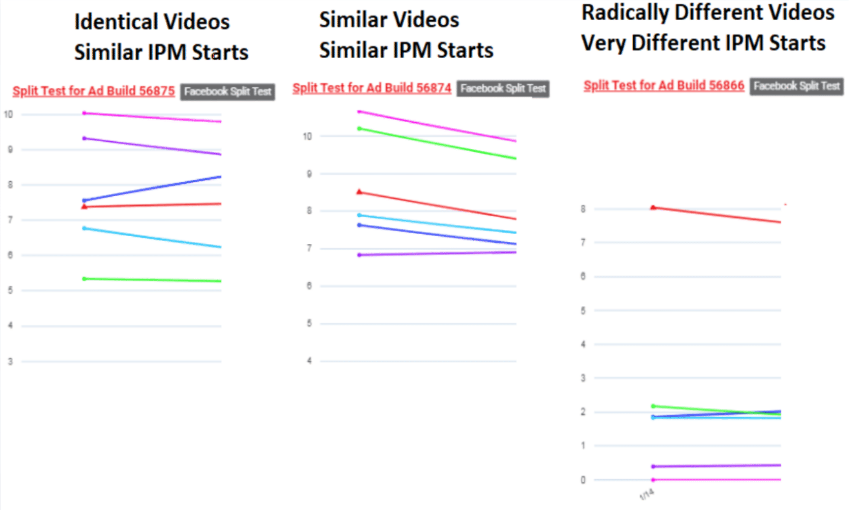
If the split-testing did not maintain creative history, the starting value for IPMs would be much closer. But as you can see in the chart above, this is not what our tests show is happening.
This feature causes test results like the one below, where we have set up a brand new test with an existing control, and right at the start, the control is granted an IPM around 8-9, but all the other (visually very different) ads get IPMs around 0-2.
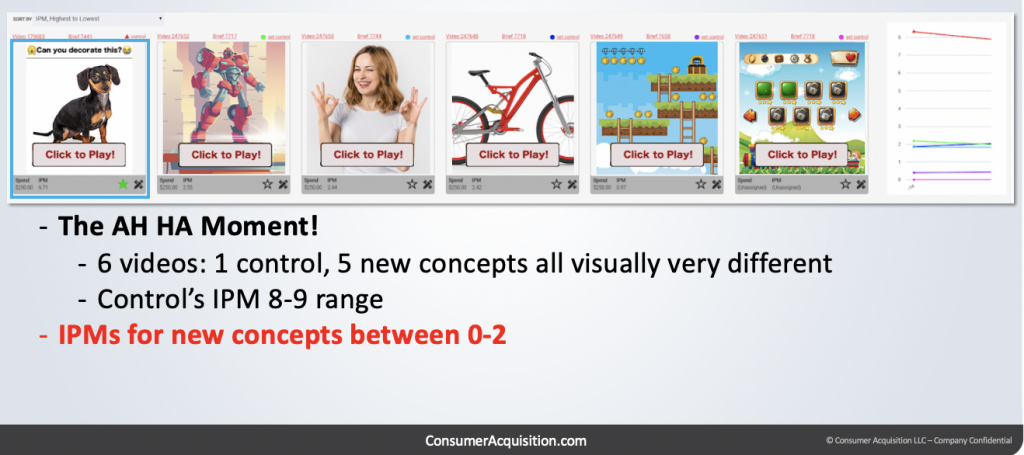
Interesting, eh?
This discovery forced us to retest a lot of creative and re-think our testing methodologies. The good news is that after re-testing a lot of our old creative, 95% of the newly retested creative that had previously failed to beat the control, actually improved its performance to an 85% failure rate (as opposed to the 95% failure rate all that creative had had before). This all resulted in a 29% lift in ROAS thanks to our new approach to testing, which takes into account the “creative history” factor in Facebook’s testing algorithm.
It took us a lot of work… but ultimately we got a 29% lift in ROAS.
So how can you work with creative history being maintained? Watch our video for the step by step process, but basically, don’t use a control video as the benchmark for testing new creative. Don’t put your control inside the split-test of your new creative concepts. Instead, run all your new creative concepts against each other – without the control. Then let these “challenger” videos build up enough learning to effectively compete with the control “champion video.”
Conclusion / What This Means For Your Mobile Gaming App
Once you understand how the social advertising platforms are changing, and you understand the power of testing, it’s clear: CREATIVE IS KING. Creative trends for mobile gaming allow you to effectively steal ideas from competitors. Mobile gaming player profiles extend the audience and performance of your ads, while enhanced creative testing saves time and money. That’s the state of creative strategy and optimization right now. Hopefully, you read this article quickly, because it all changes so fast that a new trend or a new feature may have surfaced even while you read this.
Of course, any time you want help, just contact us.


